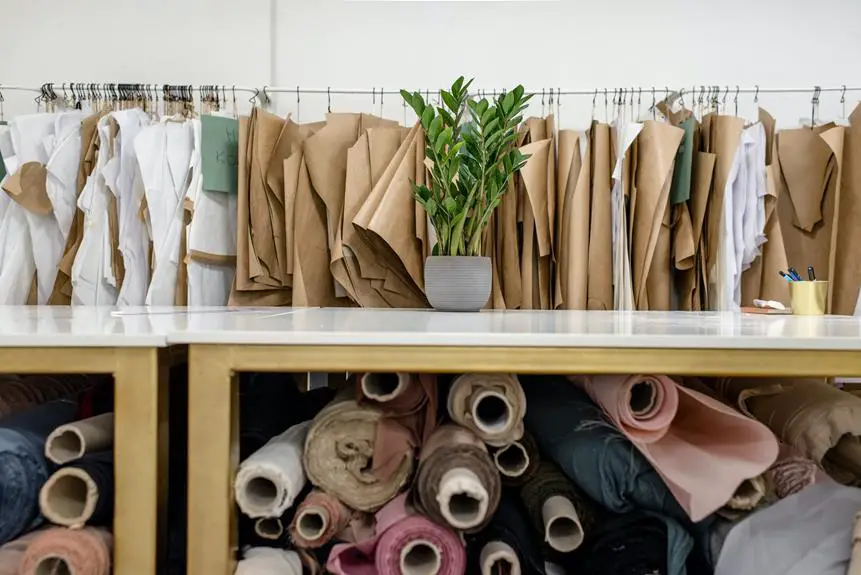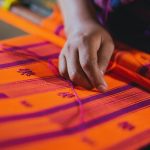Are you ready to unlock the hidden potential of your fabric projects with Sharpie markers?
Discover the endless possibilities of using Sharpie on fabric as we delve into the world of creative expression and textile artistry.
From understanding the unique properties of Sharpie markers to mastering techniques for vibrant and lasting designs, this exploration will equip you with the knowledge and skills needed to elevate your fabric creations.
With a focus on preparation, application, and preservation, you'll gain valuable insights into unleashing your creativity on fabric surfaces.
Get ready to embark on a journey of innovation and expression as we unravel the art of using Sharpie on fabric.
Key Takeaways
- Sharpie markers are suitable for use on fabric surfaces due to their permanent, quick-drying ink.
- Blending techniques can be used to achieve desired colors and effects on fabric when using Sharpie markers.
- Heat setting the design with an iron can improve the color fastness of the ink on fabric, making it more wash-resistant.
- When using Sharpie on fabric, it is important to choose a suitable fabric that is compatible with the ink and to properly prepare the fabric surface by cleaning and stretching it.
Properties of Sharpie Markers
Yes, Sharpie markers contain permanent, quick-drying ink that bonds to various surfaces, including fabric. This ink is specifically formulated to be fade-resistant and water-resistant, making it an ideal choice for fabric projects that require durability.
When using Sharpies on fabric, it's essential to understand the blending techniques to achieve the desired colors and effects. By layering different shades and using rubbing alcohol, you can create beautiful gradients and blends on fabric.
However, it's important to note that while Sharpie ink is permanent, it may fade over time with repeated washing. To combat this, heat setting the design with an iron can help improve the color fastness of the ink on the fabric. This process involves placing a cloth over the design and applying heat with an iron for a few minutes to set the ink.
Preparing the Fabric Surface
Before you start using Sharpie on fabric, it's essential to prepare the fabric surface properly.
This involves utilizing fabric prepping techniques, such as washing and ironing, to ensure a smooth and clean surface for the marker to adhere to.
Additionally, choosing a suitable fabric that's compatible with Sharpie ink will help achieve the best results.
Fabric Prepping Techniques
To use Sharpie on fabric successfully, you need to ensure that the fabric surface is properly prepped. This step is crucial for achieving the best results when using Sharpie for fabric dyeing or textile painting.
Here are some fabric prepping techniques to help you get started:
- Washing: Begin by washing the fabric to remove any dirt, chemicals, or sizing that may be present.
- Drying: Ensure the fabric is completely dry before you start working on it to prevent any unwanted bleeding or smudging.
- Ironing: Iron the fabric to remove wrinkles, as a smooth surface will make it easier to apply the Sharpie.
- Stretching: Stretch the fabric over a firm surface, such as a cardboard or foam board, to keep it taut and prevent any uneven application.
These techniques will help prepare the fabric for successful Sharpie application.
Surface Cleaning Methods
One effective way to prepare the fabric surface before using Sharpie is by thoroughly cleaning it to remove any dust, dirt, or residues.
Start by gently brushing the fabric surface with a soft-bristled brush to loosen and remove any loose particles.
Then, use a lint roller to further pick up any remaining debris.
For more stubborn stains or residues, consider using stain removal techniques such as dabbing the affected area with a mild detergent solution or using a fabric stain remover.
Always remember to spot test any cleaning method on a small, inconspicuous area of the fabric to ensure it doesn't cause damage or discoloration.
Once the fabric surface is clean and free of any contaminants, it will be ready for Sharpie application, ensuring a smooth and long-lasting result.
Choosing Suitable Fabric
Ensure the fabric you choose for your project is smooth and tightly woven to provide the best surface for Sharpie application. Using suitable materials is crucial to achieve optimal results. Fabric care is essential to prepare the surface for Sharpie application.
Here are some tips to help you choose the right fabric for your project:
- Look for fabrics such as cotton, canvas, or denim, as they provide a smooth and even surface for Sharpie application.
- Consider pre-washing the fabric to remove any sizing or chemicals that could interfere with the ink's adherence.
- Avoid loosely woven or textured fabrics, as they may cause the ink to bleed or appear uneven on the surface.
- Check the care instructions for the fabric to ensure it can withstand the heat setting process required to set the Sharpie ink.
Applying Sharpie on Fabric
You can apply Sharpie on fabric by following a few simple steps.
First, ensure your fabric is clean and dry. Place a piece of cardboard or plastic underneath the fabric to prevent the ink from bleeding through.
Then, start creating your custom designs. Whether you're drawing freehand or using stencils, the possibilities are endless.
Once your design is complete, consider using blending techniques to add depth and dimension to your artwork. You can achieve this by blending different colors together or creating gradients for a more polished look.
To blend colors, start by applying the lighter color first and then gradually layer the darker color over it. This will create a smooth transition between the shades.
After applying the Sharpie, allow it to dry for at least 24 hours. Once dry, heat set the ink by placing a cloth over the design and ironing it on a high setting for a few minutes. This will help make the design more permanent and wash-resistant.
With these simple steps, you can effectively apply Sharpie on fabric and create stunning, personalized designs.
Techniques for Blending Colors
So, you want to take your fabric art to the next level by blending Sharpie colors.
There are a few techniques you can use to achieve a seamless blend.
You can explore methods like layering for depth and creating custom shades to bring your fabric designs to life.
Color Blending Methods
Certainly!
One effective method for blending colors on fabric with Sharpie markers is by using rubbing alcohol. This technique allows for seamless color mixing and creates beautiful gradients on fabric.
Here are some color blending methods to help you achieve the perfect look:
- Rubbing Alcohol Technique: Apply different colors of Sharpie on the fabric, then use a dropper to apply rubbing alcohol, allowing the colors to blend and create stunning effects.
- Water Technique: Another method involves using water to blend colors on fabric. Apply the desired colors and then use a wet brush or cloth to blend them together.
- Layering Technique: Layering different colors on top of each other can also create unique color blends and gradients.
- Blending Markers: Utilize specific blending markers designed to seamlessly blend Sharpie colors on fabric for a professional finish.
Experiment with these techniques to find the one that best suits your project and fabric compatibility.
Layering for Depth
Layering different colors on fabric with Sharpie markers can add depth and dimension to your artwork, creating visually stunning effects.
When using Sharpies for fabric, blending techniques are essential to achieve a professional look. Start by layering light colors first, gradually building up to darker shades. This allows you to control the intensity of the colors and create smooth transitions.
To blend colors seamlessly, use overlapping circular motions, gradually transitioning from one color to the next. Experiment with different color combinations to find the perfect blend for your design. Remember to work quickly to blend the colors before they dry to avoid harsh lines.
With practice, mastering color layering and blending techniques with Sharpies will elevate your fabric art to new levels of sophistication.
Creating Custom Shades
When using Sharpies on fabric, you can create custom shades by blending colors together using effective techniques. Custom patterns and fabric dyeing are great ways to make your creations stand out. Here are some techniques for blending colors to create custom shades:
- Cross-Hatching: Use different colored Sharpies to create intersecting lines, allowing the colors to blend where they cross.
- Layering: Apply one color, let it dry, then add another color on top to create new shades and depth.
- Alcohol Blending: Use rubbing alcohol to blend different colored Sharpies together, creating a seamless transition between shades.
- Color Mixing: Experiment with layering different colored Sharpies directly on the fabric to create new custom shades.
Fixing and Setting the Colors
You can set the Sharpie colors on fabric by using heat. Once you've finished creating your custom shades, it's important to ensure that the colors stay vibrant and don't wash out. To fix the colors in place, you can use heat setting techniques.
After allowing the ink to dry completely, place a thin cloth over the colored area and iron it on a high setting for a few minutes. This will help to set the colors into the fabric, making them more resistant to washing and fading.
It's also a good idea to perform a colorfastness testing before using or washing the fabric. Simply dampen a cotton swab with rubbing alcohol and rub it firmly on a small, inconspicuous area of the fabric. If the color transfers onto the swab, the ink may not be completely set, and you may need to repeat the heat setting process.
Considerations for Washability
To ensure the longevity of your Sharpie-colored fabric, it's important to consider its washability after heat setting the colors. When it comes to washability, there are a few key considerations you should keep in mind to maintain the vibrancy and durability of your artwork.
- Fabric Compatibility: Not all fabrics are created equal. Some may be more prone to fading or bleeding when washed. Consider the type of fabric you're working with and how it may interact with the Sharpie ink.
- Durability: Think about the intended use of the fabric. Will it be subjected to frequent washing? If so, choosing a fabric that can withstand multiple wash cycles without significant fading is crucial.
- Long-Term Color Retention: It's essential to consider how well the Sharpie ink will hold up over time. Look for markers specifically designed for fabric use, as they often provide better long-term color retention.
- Fading: Keep in mind that even with proper care, some fading may occur over time. However, choosing high-quality, fade-resistant markers and following proper care instructions can help minimize this.
Considering these factors will help you select the right fabric and markers for your project, ensuring that your Sharpie-colored fabric remains vibrant and intact through numerous wash cycles.
Exploring Creative Fabric Projects
Consider incorporating Sharpie-colored fabric into your next DIY project to unleash your creativity and add a personal touch to your creations. Fabric painting with Sharpies opens up a world of possibilities for textile art. You can use this technique to create unique designs on T-shirts, tote bags, throw pillows, or even to customize your own fabric for sewing projects. The vibrant and permanent ink of Sharpies allows you to experiment with various colors and patterns, giving you the freedom to express your artistic vision.
One popular fabric painting technique is to use Sharpies to create intricate designs or illustrations on fabric, which can then be heat set to make them washable. This opens up a whole new avenue for personalized gifts, home décor, and wearable art. Moreover, fabric painting with Sharpies can be a great way to breathe new life into old or plain fabric items, adding flair and individuality to your wardrobe or living space.
Tips for Maintaining Sharpie Art on Fabric
Maintaining the vibrancy of Sharpie art on fabric requires proper care and attention to ensure longevity and durability. To prevent fading and smudging, follow these tips:
- Heat Setting: After creating your Sharpie art on fabric, use an iron to heat set the design. Place a piece of cloth over the art and apply heat for a few minutes. This helps to set the ink and prevent it from fading or smudging during washes.
- Cold Water Wash: When laundering fabric with Sharpie art, opt for a cold water wash. This helps to preserve the vibrancy of the colors and prevents the ink from bleeding or fading.
- Gentle Detergent: Use a mild and gentle detergent when washing fabric with Sharpie art. Harsh chemicals can cause the ink to fade or lose its vibrancy over time.
- Air Dry: Instead of using a dryer, air dry the fabric to maintain the longevity of the designs. High heat from dryers can cause the ink to fade or smudge, so it's best to air dry the fabric to preserve the Sharpie art.
Frequently Asked Questions
Can Sharpie Markers Be Used on Delicate Fabrics Like Silk or Chiffon?
Yes, you can use Sharpie markers on delicate fabrics like silk or chiffon for silk art and chiffon crafts. Make sure to test on a small area first and heat set the design to make it permanent.
Will the Colors of Sharpie Markers Fade or Change When Exposed to Sunlight or Heat?
Exposing Sharpie on fabric to sunlight or heat may affect colorfastness. To maintain vibrancy, consider fabric care like hand-washing. For artistic applications and DIY projects, test first and protect from prolonged exposure to sunlight or heat.
Are There Any Specific Fabric Types That Sharpie Markers Do Not Work Well On?
When it comes to fabric compatibility, certain types like silk or nylon might not work well with Sharpie markers. The key is in the marker application technique and understanding the fabric's properties for optimal results.
Can Sharpie Markers Be Used to Create Intricate Designs on Fabric, or Are They Better Suited for Simple Patterns and Shapes?
Yes, Sharpie markers can be used to create intricate designs on fabric. However, the fabric type and durability are important factors. Consider colorfastness and design longevity when using Sharpies for fabric art.
How Long Will the Sharpie Marker Designs Last on Fabric Before Showing Signs of Wear or Fading?
Sharpie marker designs on fabric can last a long time if properly maintained. Regularly washing on a gentle cycle and air-drying can help maintain the designs' durability and color fastness. With proper maintenance, the designs can remain vibrant for a considerable period.
- Does Chiffon Fabric Stink - July 15, 2025
- Does Chiffon Fabric Affect the Economy - July 15, 2025
- Does Cotton Fabric Have a Nap - July 15, 2025






